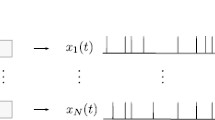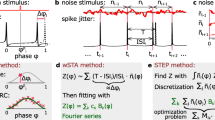Abstract
There are several different strategies to control the timing of a stimulus with respect to the ongoing discharge during the recording of neuronal stimulus-response characteristics. One possible strategy consists of delivering stimuli in such a way that a constant pre-stimulus spike density is reached. Another strategy enforces spike application with a constant stimulus latency after a spontaneous discharge. In this paper the sensitivity of these different strategies for statistical verification of small excitatory response components was investigated. It was found that the difference between observed poststimulus spike distribution and expected spike distribution under the null hypothesis of no stimulus effect was larger using a constant-stimulus-latency (CSL) strategy with an appropriate value for the stimulus latency. Thus, the statistical verification of neuronal response components is clearly facilitated if a CSL strategy is used. This superiority of the CSL strategy is marked, especially for small excitations at neurons discharging slowly with low discharge variability.
Similar content being viewed by others
References
Andreassen S, Rosenfalck A (1980) Regulation of the firing pattern of single motor units. J Neurol Neurosurg Psychiatry 43:897–906
Ashby P, Zilm D (1982) Relationship between EPSP shape and cross-correlation profile explored by computer simulation for studies on human motoneurons. Exp Brain Res 47:33–40
Awiszus F (1992a) The relationship between a neuronal cross-correlogram and the underlying postsynaptic current. Biol Cybern 67:279–283
Awiszus F (1992b) Quantification and statistical verification of neuronal stimulus responses from noisy spike train data. Biol Cybern 68:267–274
Awiszus F, Feistner H, Schäfer SS (1991) On a method to detect long-latency excitations and inhibitions of single hand muscle motoneurons in man. Exp Brain Res 86:440–446
Davey NJ, Ellaway PH, Stein BB (1986) Statistical limits for detecting change in the cumulative sum derivative of the peristimulus time histogram. J Neurosci Methods 17:153–166
Ellaway PH (1978) Cumulative sum technique and its application to the analysis of peristimulus time histograms. Electroencephalogr Clin Neurophysiol 45:302–304
Fetz EE, Gustafsson B (1983) Relation between shapes of postsynaptic potentials and changes in firing probability of cat motoneurones. J Physiol (Lond) 341: 387–410
Fournier E, Meunier S, Pierrot-Deseilligny E, Shindo M (1986) Evidence for interneuronally mediated Ia excitatory effects to human quadriceps motoneurones. J Physiol (Lond) 377:143–169
Freund H-J (1983) Motor unit and muscle activity in voluntary motor control. Physiol Rev 63:387–436
Gerstein GL, Kiang NY-S (1960) An approach to the quantitative analysis of electrophysiological data from single neurons. Biophys J 1:15–28
Kirkwood PA (1979) On the use and interpretation of cross-correlation measurements in the mammalian central nervous system. J Neurosci Methods 1:107–132
Kirkwood PA, Sears TA (1978) The synaptic connexions to intercostal motoneurones as revealed by the average common excitatory potential. J Physiol (Lond) 275:103–134
Knox CK (1974) Cross-correlation functions for a neuronal model. Biophys J 14:567–582
Knox CK, Poppele RE (1977) Correlation analysis of stimulusevoked changes in excitability of spontaneously firing neurons. J Neurophysiol 40:616–625
Malmgren K, Pierrot-Deseilligny E (1988) Evidence for non-monosynaptic Ia excitation of human wrist flexor motoneurones, possibly via propriospinal neurones. J Physiol (Lond) 405:747–764
Meunier S, Penicaud A, Pierrot-Deseilligny E, Rossi A (1990) Monosynaptic Ia excitation and recurrent inhibition from quadriceps to ankle flexors and extensors in man. J Physiol (Lond) 423:661–675
Miles TS, Türker KS, Le TH (1989) Ia reflexes and EPSPs in human oleus motor neurones. Exp Brain Res 77:628–636
Moore GP, Perkel DH, Segundo JP (1966) Statistical anlaysis and functional interpretation of neuronal spike data. Annu Rev Physiol 28:493–522
Polyakov AV (1991) Synaptic noise and the cross-correlation between motoneuron discharges and stimuli. NeuroReport 2:489–492
Author information
Authors and Affiliations
Rights and permissions
About this article
Cite this article
Awiszus, F. Sensitivity of different stimulus-timing strategies for the detection of small excitations in noisy spike train data. Biol. Cybern. 68, 553–558 (1993). https://doi.org/10.1007/BF00200815
Received:
Accepted:
Issue Date:
DOI: https://doi.org/10.1007/BF00200815




